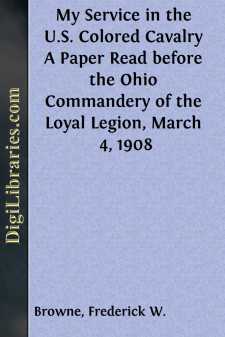Categories
- Antiques & Collectibles 13
- Architecture 36
- Art 48
- Bibles 22
- Biography & Autobiography 813
- Body, Mind & Spirit 142
- Business & Economics 28
- Children's Books 16
- Children's Fiction 13
- Computers 4
- Cooking 94
- Crafts & Hobbies 4
- Drama 346
- Education 46
- Family & Relationships 57
- Fiction 11829
- Games 19
- Gardening 17
- Health & Fitness 34
- History 1377
- House & Home 1
- Humor 147
- Juvenile Fiction 1873
- Juvenile Nonfiction 202
- Language Arts & Disciplines 88
- Law 16
- Literary Collections 686
- Literary Criticism 179
- Mathematics 13
- Medical 41
- Music 40
- Nature 179
- Non-Classifiable 1768
- Performing Arts 7
- Periodicals 1453
- Philosophy 64
- Photography 2
- Poetry 896
- Political Science 203
- Psychology 42
- Reference 154
- Religion 513
- Science 126
- Self-Help 84
- Social Science 81
- Sports & Recreation 34
- Study Aids 3
- Technology & Engineering 59
- Transportation 23
- Travel 463
- True Crime 29
My Service in the U.S. Colored Cavalry A Paper Read before the Ohio Commandery of the Loyal Legion, March 4, 1908
Categories:
Description:
Excerpt
MY SERVICE IN THE U. S. COLORED CAVALRY
Having served over two years in a good, hard-fighting infantry regiment, and being encamped at Newport News, Va., holding the dignified rank of Sergeant, I one day met our little fighting Major John G. Chambers who asked me if I would like a commission in the 1st U. S. Colored Cavalry, then forming at Fort Monroe, to which I made answer that I would, and two or three days thereafter I received an order, mustering me out of the service and also an order to report to Colonel Garrard for duty as an officer of the new regiment. Early the next morning, going down to the wharf to embark for Ft. Monroe, I showed to the sentry on the wharf (as my authority for leaving) the order mustering me out. He looked it over and said in a home-sick way, “I would give $800 for that paper.” I reported to Colonel Garrard, and for the first time saw this officer with whose reputation as a brave and efficient Major of the 3d N. Y. Cavalry I had been well acquainted in the Department of North Carolina. This regiment, being the first colored cavalry regiment, had in its ranks a rather better class of men than the infantry regiments had; some being from the North and some being the outlaw negroes who, in slavery times, had been able to maintain their liberty in the swamps of Eastern Virginia and North Carolina. The regiment was officered largely from the 3d N. Y. Cavalry, and they were a thoroughly efficient and capable corps of officers. The regiment was soon filled, mounted and equipped, and constant drill soon made it have the manner and bearing of soldiers. Every one knew that the Campaign of 1864 meant business, and therefore all was in readiness when about May 1st orders came to move. We marched out through Hampton, of which not one house was left except the little old stone church which is still standing there. Through Big Bethel, the scene of one of the earliest disasters of the war, to Yorktown, memorable for its two sieges in two wars, and thence on to Williamsburg, passing between Yorktown and Williamsburg our infantry who, much to our surprise were marching very hurriedly back to Yorktown. We learned afterward they were put on board transports at Yorktown and sent up the James to City Point and Bermuda Hundred. The next day we went up the Peninsula, passing 6 and 12 Mile and burnt ordinarys, camping at night at New Kent Court House. I commanded the picket that night on the Bottoms Bridge Road and the enemy’s scouts were against us all night, keeping matters well stirred up. The next morning we turned South and met the enemy at Jones Ford on the Chickahominy. They were in an earthwork across the Ford and we opened on them with our howitzers in front and deployed as to cross in front, but a force was sent to the right up stream who managed to cross, and, coming down on the opposite side of the river, took the enemy in flank and soon drove them away from the ford. Killing some and capturing some of the enemy, and having some killed and wounded, our movement having been a feint to make the enemy believe that Butler’s Army of the James, as it was afterward called, was moving up the Peninsula, having been accomplished, we returned to Williamsburg, arriving there the next day, where, to our astonishment, we met an order to go back at once and cross the Chickahominy at Jones Ford, sometimes called Jones Bridge, and proceed to Harrison’s Landing, which we at once did, again fighting our way across at Jones Ford....


